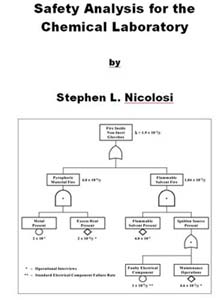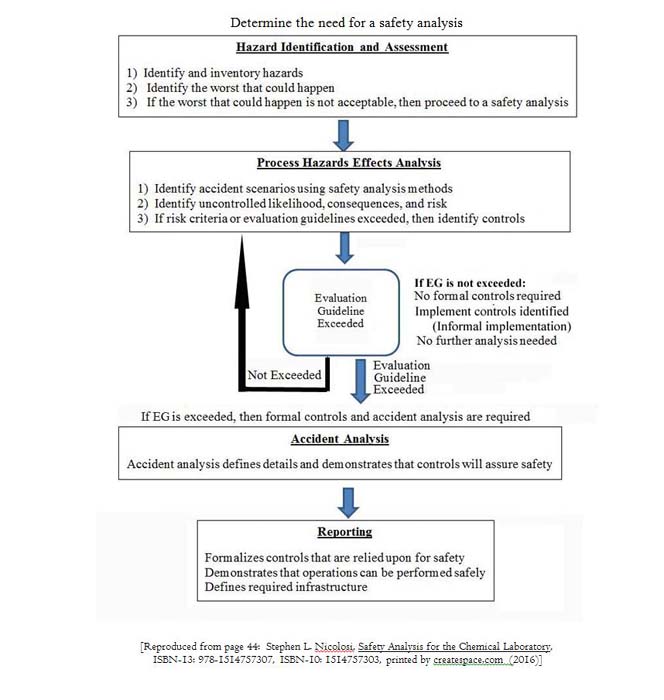Safety Analysis for the Chemical Laboratory
by Stephen L. Nicolosi
ISBN-13: 978-1514757307, ISBN-10: 1514757303

Safety analysis is the application of predictive methods to identify
and evaluate potential hazards presented by a system or operation which
are above and beyond those controlled by established good practices.
It includes initiating events from within a system, including human errors,
equipment failures, and unknown parameters as well as initiating events external
to a system (e.g., power failure, external fires, traffic accidents, and aircraft accidents),
in addition to natural phenomena events
(e.g., high winds, earthquake, low temperatures, flooding, and lightning).
The RAMP (Recognize, Assess, Minimize, Prepare) philosopy, which is not addressed in the text,
helps to establish the baseline of good practices that a safety analysis and associated
risk assessment assume to be in-place.
Chapter Headings
1. Safety Analysis and its Origins
2. Measuring Safety
3. To Analyze or Not to Analyze
4. Estimating Consequences
5. Estimating Likelihood
6. Controls for Prevention and Mitigation
7. Hazard Identification and Assessment
8. What-If Analysis
9. Preliminary Hazard Analysis
10. Failure Mode and Effects Analysis
11. Fault Tree Analysis
12. Event Tree Analysis
13. Human Reliability Analysis
14. Hazards and Operability Studies (HAZOPS)
15. Reliability Analysis
16. Process Hazards Effects Analysis (PHEA)
17. Accident Analysis
18. Configuration Management
19. Reporting
20. Safety Reviews
21. Risk Awareness
22. Thinking in Failure Space
23. Credits
24. References
Index
Table of Contents
1. Safety Analysis and its Origins 1
1.1. Safety and Safety Analysis 1
1.2. Safety Analysis and the Laboratory 2
1.3. Impacts on Laboratory Researchers and Facility Operations 3
1.4. Origins of Safety Analysis and Safety Analysis Techniques 4
1.4.1. Commercial Nuclear Power Safety Analysis 4
1.4.2. Defense and Aerospace Safety and Reliability Studies 7
1.4.3. Automotive Industry Safety Applications 8
1.4.4. Chemical Process Safety Analysis 10
2. Measuring Safety 13
2.1. Safety and Risk 13
2.1.1. Measuring Safety in the Chemical Laboratory 19
2.1.1.1. Qualitative Consequence Measures for the Chemical Laboratory 21
2.1.1.2. Qualitative Likelihood Measures for the Chemical Laboratory 24
2.1.1.3. Qualitative Risk Measures for the Chemical Laboratory 26
2.1.1.4. Safety Evaluation Guideline 27
2.1.1.4.1. A Safety Evaluation Guideline for the Chemical Laboratory 29
2.2. Risk and Life 30
2.2.1. General Societal Risks 31
2.2.2. Risk of Our Sun Going Nova 32
2.2.3. Safety Requirements for US Nuclear Weapons 33
2.2.4. US NRC and Reactor Safety 37
2.3. Risk Acceptance 40
3. To Analyze or Not to Analyze 42
3.1. Familiar Refrain or When to Analyze 42
3.2. General Approach to Performing a Safety Analysis 43
3.2.1. A Closer Look at the Basic Steps of a Safety Analysis 45
3.2.1.1. Determine the Need for a Safety Analysis and Its Objectives 46
3.2.1.1.1. Who Will Perform the Safety Analysis 48
3.2.1.2. Process Hazards Effects Analysis Phase 48
3.2.1.2.1. Identify Potential Accident Scenarios 49
3.2.1.2.2. Group Accident Scenarios into Representative and Unique Scenarios 50
3.2.1.2.3. Construct Process Hazards Effects Table 50
3.2.1.2.4. Evaluate Accident Scenarios Without Considering Controls 50
3.2.1.2.5. Identify Preventive and Mitigative Controls as Needed 51
3.2.1.2.5.1. Hierarchy of Controls and Associated Implications 52
3.2.1.2.5.2. Tabulate Controls 54
3.2.1.3. Perform Detailed Accident Analysis 55
3.2.1.4. Document, Review, and Approve Safety Analysis 56
3.3. Overview of Safety Analysis Methods 56
3.4. Single Failure Versus Multiple Failure Events 59
3.5. Laboratory Variations 60
3.5.1. Laboratory of limited complexity with repetitive operations 61
3.5.2. Laboratory performing varying operations of limited complexity with little repetition using small quantities of reagents 63
3.5.3. Undergraduate student laboratory where students perform the same experiments each year 64
3.5.4. Undergraduate or graduate student research laboratory 66
3.5.5. University or other research laboratory staffed largely by faculty or other professional chemists 69
3.5.6. Laboratory handling highly hazardous materials 70
3.5.7. Laboratory with hazardous materials where failure of a support system initiates unacceptable events 73
3.5.8. Safety Analysis of Laboratory Equipment 74
3.5.9. Experiment interfaced to operationally simple equipment 77
3.5.10. Experiment interfaced to operationally complex equipment 78
3.5.11. Laboratory support operation (e.g., receiving and preparing reactive material for use) 79
3.5.12. A laboratory planning a complex experiment, test, or other operation 81
4. Estimating Consequences 83
4.1. Methodology 84
4.2. Source Terms 85
4.2.1. Evaporation from Pools 86
4.2.1.1. US EPA Method for Evaporation from Pools 87
4.2.1.2. Stiver and Mackay Method Developed for Hydrocarbon Spills 87
4.2.1.3. Kawamura and Mackay Method 88
4.2.2. Release Fractions 92
4.2.3. Respirable Particulates 94
4.2.3.1. Aerosol Removal Mechanisms 94
4.2.3.2. Particle Size 96
4.2.3.3. Aerodynamic Diameter 101
4.2.3.4. Aerosol Size Distributions 102
4.2.3.4.1. Lognormal Distribution 103
4.2.3.4.2. Power-law Distribution 108
4.2.3.4.3. Modified Gamma Distribution 109
4.2.3.5. Aerosol Agglomeration 110
4.2.3.6. Aerosol Deposition in the Respiratory System 111
4.3. Dilution, Dispersion, and Plume Transport 112
4.3.1. The Well-Mixed Room 113
4.3.2. The Well-Mixed Room with Dilution 113
4.3.3. Plume Dispersion 116
4.3.3.1. Gaussian Model for Neutrally Buoyant Plume 116
4.3.3.2. Bounding Dispersion Analysis 119
4.3.4. Heavy Gas Dispersion 120
4.3.5. Large Spills and Releases 122
4.4. Consequence Measures 123
4.4.1. Injection 123
4.4.2. Ingestion 123
4.4.3. Inhalation Exposure 124
4.4.4. Contact Exposure 127
4.4.5. Irradiation Exposure 127
4.4.5.1. Non-ionizing Radiation 128
4.4.5.2. Ionizing Radiation 129
4.4.5.2.1. Photon Interactions with Matter 130
4.4.5.2.2. Charged Particle Interactions with Matter 133
4.4.5.2.3. Estimating Incident Gamma and X-Ray Fluxes 137
4.4.5.2.4. Measuring Ionizing Radiation Exposure 145
4.4.5.2.5. Measuring Ionizing Radiation Dose 146
4.4.5.2.6. Exposure and Dose from External Exposure to Ionizing Radiation 148
4.4.5.2.7. Estimating Dose from Inhalation of Radioactive Material 149
4.4.5.2.7.1. Breathing Rate 152
4.4.6. Overpressure Exposure 153
4.4.6.1. TNT Equivalent 156
4.4.6.2. Ignition 164
4.4.6.3. Deflagration 171
4.4.6.4. Detonation 173
4.4.6.5. Physical Explosions 176
4.4.6.5.1. Pressure Vessel Rupture 176
4.4.6.5.2. Boiling Liquid Expanding Vapor Explosion (BLEVE) 177
4.4.6.5.3. Rapid Phase Transition 177
4.4.6.6. Vapor Cloud Explosions and Gas Explosions 178
4.4.6.6.1. TNT Equivalency for Vapor Cloud and Gas Explosions 179
4.4.6.6.2. Blast Curves for Vapor Cloud and Gas Explosions 180
4.4.6.6.2.1. Baker-Strehlow-Tang Method 180
4.4.6.6.2.2. TNO Multi-Energy Method 181
4.4.6.7. Dust Explosions 182
4.4.6.8. Estimating Overpressure from TNT Equivalent 186
4.4.6.9. Overpressure Effects 188
4.4.6.10. Identifying Potentially Explosive Chemicals 193
5. Estimating Likelihood 201
5.1. Equipment Failure Rates and Probabilities 203
6. Controls for Prevention and Mitigation 212
7. Hazard Identification and Assessment 222
8. What-If Analysis 227
9. Preliminary Hazard Analysis 231
10. Failure Mode and Effects Analysis 234
11. Fault Tree Analysis 248
11.1. Introduction 248
11.2. Fault Tree Symbols and Example Fault Tree 248
11.3. Boolean Operations and Fault Tree Cut-Sets 251
11.4. Quantifying Fault Trees 256
11.4.1. Evaluating an OR gate 256
11.4.2. Evaluating an EXCLUSIVE OR gate 258
11.4.3. Evaluating an AND gate 258
11.4.4. Common Cause Failures 259
12. Event Tree Analysis 264
13. Human Reliability Analysis 265
13.1. Overview of Human Reliability 265
13.2. Human Error Probabilities 274
13.3. Human Error Checklists 281
13.4. Human Reliability Analysis Methods 284
13.4.1. Technique for Human Error Rate Prediction (THERP) 288
13.4.2. Application of Bayesian Analysis 293
14. Hazards and Operability Studies (HAZOPS) 298
14.1. Introduction 298
14.2. HAZOPS and the Chemical Laboratory 298
14.3. HAZOPS Preliminaries 299
14.3.1. The HAZOPS Team 299
14.3.2. Process Diagram 299
14.3.3. Process Description 300
14.4. HAZOPS Methodology 300
14.5. Documenting a HAZOPS 302
15. Reliability Analysis 308
15.1. Introduction 308
15.1.1. Selected Distributions 308
15.1.1.1. Binomial 308
15.1.1.2. Poisson 309
15.1.1.3. Beta 309
15.1.1.4. Gamma (inverse scale and scale) 310
15.1.1.5. Weibull 311
15.1.1.6. Exponential (inverse scale and scale) 311
15.1.1.7. Lognormal 312
15.2. Reliability, Failure, and Hazard Functions 313
15.2.1. Using Reliability and Failure Data 315
15.2.2. The Hazard Function 316
15.2.2.1. Constant hazard function 317
15.2.2.2. Linearly Increasing Hazard Function 317
15.2.2.3. Linearly Decreasing Hazard Function 318
15.2.2.4. Hazard Function from a Weibull Failure Density Function 318
15.2.2.5. Component Failure Rates and the Bathtub Curve 319
15.2.3. Mean Time to Failure and Unavailability 321
15.3. Bayesian Inference for Updating Data 322
15.3.1. Conjugate Functions and the Binomial and Beta Distributions 324
15.3.2. Conjugate Functions and the Poisson and Gamma Distributions 326
15.3.3. Assigning Parameters for a Prior Distribution 329
15.3.3.1. Maximum Likelihood Estimation 329
15.3.3.2. Method of Moments 330
15.3.3.2.1. Method of Moments for the Gamma Distribution 331
15.3.3.2.2. Method Of Moments for the Beta Distribution 332
15.3.4. Informative, Noninformative, and Constrained Prior Distributions 332
15.3.4.1. Priors Associated With an Extensive Knowledge Base 333
15.3.4.2. Prior Distributions for Which Nothing is Known 333
15.3.4.3. Prior Distributions When Something is Known 335
16. Process Hazards Effects Analysis (PHEA) 336
17. Accident Analysis 349
18. Configuration Management 350
19. Reporting 351
19.1. Format and Content of a Safety Analysis Report 351
20. Safety Reviews 353
21. Risk Awareness 356
22. Thinking in Failure Space 362
23. Credits 363
23.1. Referenced data presented in tables 363
23.2. Figures used, adapted, or redrawn 368
24. References 371
Index 408
Safety Analysis and Risk Assessment Process
